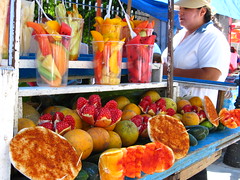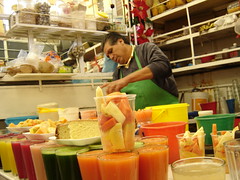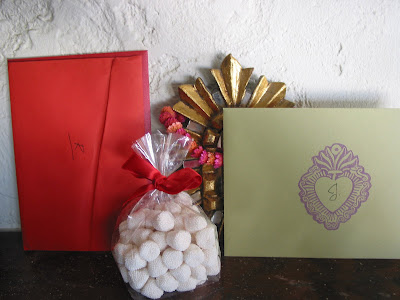Thursday, February 26, 2009
Fruit vendor
Another wonderful photo by MaluMaPe, who often posts to a Mexican food forum on Flickr. This is a little fruit cart selling fruit spears, pomegranates, oranges and jicama (generously dusted with chile powder).
Juice stall in Mexico
Nice photo by MaLuMape, from Celaya! It features a "Jugueria". Here you can see glasses of papaya, strawberry, orange, apple and grapefruit juice. The green one is alfalfa sprout juice I believe...or maybe cactus?
Gracias MaLuMape!
Wednesday, February 25, 2009
Vegetarian diets: Mexican style
I remember taking a health class not too long ago where the teacher made the following blanket statement: "Mexican food can be healthy if prepared without meat and cheese." I had a talk with him and argued that a more accurate statement would have been "Any cuisine can be healthier if you eliminate meat and cheese." We had a great talk and I eventually came to admire and respect him, but that conversation got me thinking...Mexican vegetarian traditions are still unknown on this side of the border.
Here's some musings about vegetarian diets, Mexican style:
Beyond the Taqueria
Have you ever wondered why Taqueria food features brains, tongue and tripe? These cuts of meats were cheap and considered leftovers, but widely used because of their affordability. Unfortunately this type of food has become the "signature" Mexican cuisine here in the US. In fact, many regional Mexican cuisines feature a lot of vegetarian options for that reason: Meat is considered a luxury.
Carnaval: Goodbye to meat!
In Mexico, Carnaval is celebrated the week before Ash Wednesday. It is a time for revelrie and debauchery before the more solemn "Semana Santa" or Easter celebrations. Carnaval literally means "goodbye to meat". In a largely Catholic population even the most devoted meat eater goes vegetarian for 40 days if they observe vigilia, or Lent.
Nothing new
Ancient Mexicans were mostly vegetarian. The original Mesoamerican diet was comprised of squash, peppers, beans and corn. Even Oprah featured a show on "Blue Zones", or places where people live longer. The longevity of people in certain areas of Central America may be directly linked to a vegetarian diet that has been around for more than 3000 years.
Salad, or salsa?
Tomato salsa is very popular in the US. In Mexico the word salsa actually means "sauce" and there's a lot of different varieties, from the raw to the cooked. Raw salsas often include the same ingredients used to prepare salads, like peppers, onions and some times fruit. Pico de gallo, an orange chopped salad that includes jicama and cucumbers is a good example. If chopped in smaller cubes the salad becomes a fresh salsa!
Jugos y licuados.
Some market stalls in Mexico exclusively sell vegetarian or vegan drinks. They are called juguerias (see my next post). They feature jugos (juice) delicious aguas frescas (fruit drinks) and licuados (smoothies). Fruit is also a popular snack. Some street vendors sell fruit spears, often seasoned with lime, salt and chili pepper.
Go verde
If you speak Spanish you know that verde is the word for the color green. Verdura or "greenery" is a word used interchangeably to describe edible greens and salad. Many dishes include verdura in the form of shredded lettuce, radishes, green onions and avocado...mostly as a side dish or garnish. However, there are many other types of verduras. Here's a few:
Xoconostles, chayotes, nopales...Oh my!
Mexico contributed chocolate, vanilla, avocadoes, tomatoes and corn to the world's diet, among many other foods. There's a lot of fruits, grains and vegetables commonly eaten south of the border that are just waiting to be discovered here in the US! Here's some examples:
Here's some musings about vegetarian diets, Mexican style:
Beyond the Taqueria
Have you ever wondered why Taqueria food features brains, tongue and tripe? These cuts of meats were cheap and considered leftovers, but widely used because of their affordability. Unfortunately this type of food has become the "signature" Mexican cuisine here in the US. In fact, many regional Mexican cuisines feature a lot of vegetarian options for that reason: Meat is considered a luxury.
Carnaval: Goodbye to meat!
In Mexico, Carnaval is celebrated the week before Ash Wednesday. It is a time for revelrie and debauchery before the more solemn "Semana Santa" or Easter celebrations. Carnaval literally means "goodbye to meat". In a largely Catholic population even the most devoted meat eater goes vegetarian for 40 days if they observe vigilia, or Lent.
Nothing new
Ancient Mexicans were mostly vegetarian. The original Mesoamerican diet was comprised of squash, peppers, beans and corn. Even Oprah featured a show on "Blue Zones", or places where people live longer. The longevity of people in certain areas of Central America may be directly linked to a vegetarian diet that has been around for more than 3000 years.
Salad, or salsa?
Tomato salsa is very popular in the US. In Mexico the word salsa actually means "sauce" and there's a lot of different varieties, from the raw to the cooked. Raw salsas often include the same ingredients used to prepare salads, like peppers, onions and some times fruit. Pico de gallo, an orange chopped salad that includes jicama and cucumbers is a good example. If chopped in smaller cubes the salad becomes a fresh salsa!
Jugos y licuados.
Some market stalls in Mexico exclusively sell vegetarian or vegan drinks. They are called juguerias (see my next post). They feature jugos (juice) delicious aguas frescas (fruit drinks) and licuados (smoothies). Fruit is also a popular snack. Some street vendors sell fruit spears, often seasoned with lime, salt and chili pepper.
Go verde
If you speak Spanish you know that verde is the word for the color green. Verdura or "greenery" is a word used interchangeably to describe edible greens and salad. Many dishes include verdura in the form of shredded lettuce, radishes, green onions and avocado...mostly as a side dish or garnish. However, there are many other types of verduras. Here's a few:
- Verdolagas. Known as purslane in English. It has a pleasant sweet-sour flavor.
- Romeritos. Succulent leaves similar to a young, tender rosemary leaf.
- Quelites. The word comes from the Nahuatl "quilitl", meaning any edible wild herb. There are many kinds of quelites that grow wild in Mexico.
- Popalo. Round little leaves, often used inside Tortas, or Mexican sandwiches.
- Chipilin. Deliciously fragrant leaves, often used to prepare tamales and soups. Very popular in southern Mexico and Central America.
- Epazote. This strong tasting herb is used as a seasoning, but some times it is also used as a verdura. For example, some quesadillas include fresh epazote leaves.
- Chaya. Large green fuzzy leaves. In Chiapas they are steamed or pan friend, they remind me a bit of kale or green chard.
- Momo. Also known as hoja santa meanign "sacred herb" (pictured below). This plant is also used to prepare tamales, it has a delicate taste similar to anise. Some folks in Southern mexico use the momo leaves to make tasty little wraps, in the same manner you would use a tortilla.
Xoconostles, chayotes, nopales...Oh my!
Mexico contributed chocolate, vanilla, avocadoes, tomatoes and corn to the world's diet, among many other foods. There's a lot of fruits, grains and vegetables commonly eaten south of the border that are just waiting to be discovered here in the US! Here's some examples:
- Mamey. It is elongated like an avocado, but it has brick colored flesh and a shinny black pit. It has a delicate flavor somehow similar to papaya but sweeter and creamier.
- Chayotes. Pear shaped squash. They are very popular, often boiled and eaten like vegetables, but they are technically fruits.
- Manchi. Also known as nanche. It resembles a small yellow cherry. They are a bit mealy, they are often marinated in rum and eaten as a dessert.
- Tejocotes. They are little fragrant fruits similar to crab apples.
- Guajes, caspiroles. These are seed pods, eaten raw or cooked. Guajes are cooked like green beans. Caspiroles have a sweet, fuzzy flesh. The taste is similar to lychee fruit.
- Tunas. No, not tuna fish! These are cactus fruits - they come in green, yellow and a beautiful magenta color.
- Nopales. Tender cactus, they are eaten cooked. The taste and consistency is similar to okra.
- Xoconostles. They are like tunas, but sour.
- Jocotes. Round sweet fruits, similar to plums.
- Moras. A variety of wild berries.
- Zapotes. Similar to mamey, but round.
Monday, February 23, 2009
Mini meat
Labels:
Altars and vignettes,
From my Studio,
Miniatures
Thursday, February 19, 2009
Koshland Park: Sustainable food and art!
Koshland is build on the side of a hill. The front of the park is at street level, where you can find a basketball court and a playground. The side of the park towers over a tall concrete wall that supports the hill. You can see lots of wonderful tile art by community members and ToT (Justine Tatarsky). The wall is dedicated to the family of children lost to violence in the Western Addition. The park has a view of the San Francisco Zen Center and part of the downtown skyline.
It does feel very nice and peaceful on top of the hill. Here's some pictures of community members and their art from Justine Tatarsky's website. I hope to write more about Justine's wonderful tile artwork soon!
Further back is another reason Koshland park is so unique and a great example for other neighborhoods. There is an organic garden and living classroom ran by HVNPG (Hayes Valley Neighborhood Parks) built over a series of terraces.
With programs like "Beet Rangers" and the "LetUsGrow" summer camp, young neighborhood residents get a chance to learn about gardening and sustainability. Students also learn to cook the fruit of their labor with the "Seed to Mouth program". Take a look at The Koshland Park Blog to learn more about these cool programs! You can make donations for HVNPG at the Tides Center.
If you want to visit, the park is located on Page and Buchanan streets, in San Francisco.
Saturday, February 14, 2009
Friday, February 13, 2009
Bird nest at Civic Center...

I was walking to the farmer's market when I had the pleasure of watching artist Patrick Dougherty and an assistant working high on a scaffolding. He was making one of his signature twig sculptures on the trees in front of Civic Center. Looks to me like they were weaving and arranging twigs in order to create the sculptures using no special tools, just their bare hands!

Doesn't it look like a cute dwelling out of an Ewok village? (OK, I'm a nerd for not coming up with a better comparison). I asked the artist how many pods/nests he was going to make. He said that he could make several. So far he had one and was working on another. What I like about this type of installation is that the artist uses readily available natural materials (look at all the twigs available - he could make a whole Ewok city!) so it is a really "green" way of creating.

The final piece blends in and looks like it belongs to the trees on site. I can't wait to go back this weekend and look at the progress. Please visit Mr. Dougherty's website, stickwork.net and see more of his amazing work.

Wednesday, February 11, 2009
Opening of Strange Hope!
Last Friday Galeria de la Raza held a reception for Strange Hope, an exhibit honoring new beginnings, creativity and resourcefulness! The participating artists traded art pieces trough a one time lottery.
Guillermo Gomez Peña performed an inspiring piece about trading, cautious optimism and the role of artists in new creative economies. I won a piece by Jaime Cortez, who was also the event's Master of Ceremonies! How lucky am I?

Tuesday, February 10, 2009
Valentine's Botanica
I created these items for a recent Artist Bazaar at Galeria de la Raza. I was inspired by items you would find in a Botanica (Latin stores that sell folk remedies). Please check Galeria's calendar for future events, and help support local artists!








Labels:
Altars and vignettes,
From my Studio,
Handmade
Friday, February 6, 2009
More pretty luchadores

I was walking my dog one day when I saw David Gremard Romero's work at Bucheon, a neighborhood gallery on Hayes Valley. I did a double take. Was that a lucha libre costume? Yes it was! The interestingly named exhibit "Auto-Da-Fe" included paintings, pastel drawings and beautifully embroidered luchador costumes. Rather than using the luchador as just a campy novelty, the artist richly layered his work with historical and cultural meaning.

In colonial Mexico, an Auto-Da-Fe (literally meaning, "act of faith") was an Inquisitorial process most often associated with the public burning of heretics. The condemned prisoners often wore "San Benitos", or long penitential tunics painted with flames and devils. To the native population this act may have mirrored some rites performed by Mesoamerican priests, like human sacrifices or ritualistic ball games. So, what am I getting at? Both were civic and religious occasions that where also social events. Social events always require good costumes!
 Masks, capes and tights become important accessories of the luchador as a modern day super hero/warrior. Gremard Romero's work deals with the syncretism of lucha libre costumes and pre-hispanic mythology. Most of his luchador costumes are named after Mexica ("Aztec") deities. The works also touches on the homoerotic connotations of hyper-masculine activities like wrestling and male bonding at sporting events. Most importantly, Gremard Romero's visions bring a contemporary Chicano perspective to colonial painting and the textile traditions of the Americas. It also makes me wonder about our present day acts of faith: The cult of heroism, present time gladiators, the Superbowl, and wearing your favorite team's colors...and larger issues of multiculturalism, painful history and identity politics.
Masks, capes and tights become important accessories of the luchador as a modern day super hero/warrior. Gremard Romero's work deals with the syncretism of lucha libre costumes and pre-hispanic mythology. Most of his luchador costumes are named after Mexica ("Aztec") deities. The works also touches on the homoerotic connotations of hyper-masculine activities like wrestling and male bonding at sporting events. Most importantly, Gremard Romero's visions bring a contemporary Chicano perspective to colonial painting and the textile traditions of the Americas. It also makes me wonder about our present day acts of faith: The cult of heroism, present time gladiators, the Superbowl, and wearing your favorite team's colors...and larger issues of multiculturalism, painful history and identity politics.
Enjoy David Gremard Romero's work at his website.
Labels:
Art,
History,
Mexican Heritage,
Painting,
Textiles
Wednesday, February 4, 2009
Love wrestle
I have to say I never got into Mexican wrestling much...or "regular" wresting for that matter. My father took me to a match once and I got incredibly bored. Mexican wrestlers seem to be very popular lately. These cool valentines featuring masked luchadores remind me of the posters you could see on the street advertising "La Arena Mexico", or "La Arena Coliseo", Mexico City's premier wresting palaces! Cute concept by yee-haw industries, as seen on the super fab sfgirlbybay. Only one small clarification - it is spelled "Amor" without the E, and in Spanish speaking countries we would say "El Dia de San Valentin". Valentino will always make me think of the silent movie actor....


Tuesday, February 3, 2009
More hearts

This image is from a window display at Polanco, a gallery of Mexican arts in San Francisco. The display features a red rebozo, jewelery, silver milagro ornaments and a black clay heart. Very nice!
Monday, February 2, 2009
Hearts, candy and the color red...


The first two images are from Jaime Hayon's Crystal Candy set, created for Baccarat (as seen at Yatzer). These crystal pieces do remind me of candy! The red crystal topped with white ceramic on the right looks like a combination of a heart, a hand grenade and a pomegranate. The second image is from a papier mache box that I created using newspaper, cardboard and acrylic paint.

A very philosophical fellow artist once told me that every day has its own color (cada dia tiene su color). It means that we should savor the unique differences of each day that passes by. But what about months? Do they have their own unique "shade"? With so many Valentine's day merchandise like roses, hearts and ribbons, red may as well be this month's color. And what color has more emotional connotations? Here's some curious musings about red:
Urban legends claim that more red cars get speeding tickets. Snopes debunks this myth here.
In China, red is considered a lucky color.
Bull fighters tease the bull with red capes.
To be "in the red" means you are loosing money.
Santa, as well as Satan and high ranking religious persons (like Cardinals and the Pope) are often depicted in red.
Red was associated with Communism.
In Santeria, red is associated with the Orisha Chango, the deity of thunder, war and fire.
In several countries red means "stop" or "caution".
James Dean wore a red windbreaker in the movie "Rebel without a cause". Can you imagine if he had worn, say, a powder blue jacket?
A burial site in Palenque, Chiapas, was discovered generously sprinkled with a pigment known as cinnabar, giving the bones of the mysterious woman buried there a bright red color. This picture of the so called "Red Queen" comes from Diario Yucatan

So, enjoy the color red this (or any other) month. Happy February!
Subscribe to:
Comments (Atom)






















